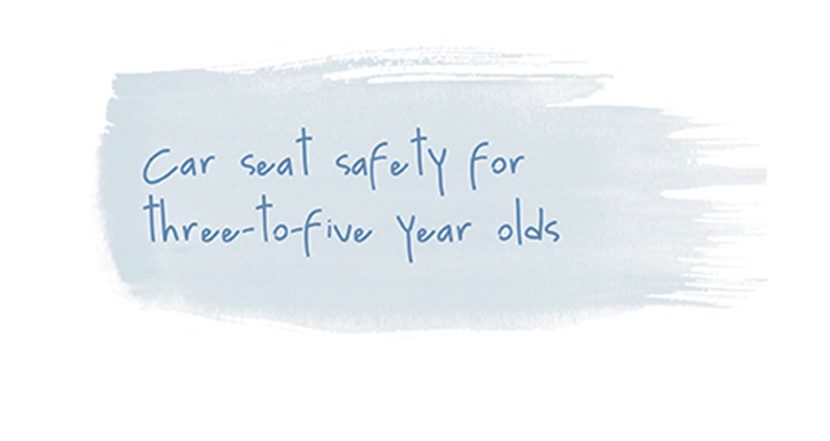Car seat safety 3- to 5-year olds

Many children move into boosters or adult belts with no booster before they are ready because their younger siblings need their seat or because their peers are in boosters too.
Please don't demote your child to a booster seat because their carseat is needed for a younger sibling. Think about buying or renting another carseat with harness until they are physically ready for a booster seat or adult belt. Don't use what other restraints your child's peers are using (if any) as an indication that they should move into a booster. Every step in carseat "advancement" is actually a step down in your child's protection.
A forward-facing restraint with an inbuilt harness offers the most protection for your child, although at some point they will need to use a booster seat. They have outgrown their child seat if their eyes are above the top back of the plastic shell of the seat and/or they weigh 18kg (whatever comes first).
If this is the case, we suggest:
- Find another car seat, e.g. a convertible booster. Convertible boosters still use inbuilt harnesses up until 18kg, but typically have taller backs and higher harness slots then normal child seats, accommodating your child for longer. Newer designs of convertible boosters may also allow for the use of an installed child harness (bought separately) right up to 26kg. Make sure such convertible boosters used in conjunction with separate child harnesses are ALWAYS used with the anti-submarine feature that is present in the seat.
Whilst you can use a child harness in conjunction with some booster seats, it is suggested that the booster seat have an anti-submarine device or "clip" to ensure the lap portion of the belt does not ride up on to the abdomen of the child.
NEVER over-tighten a child harness. It is vital that you make sure the child harness is fitted correctly according to the manufacturer's instructions. It is also critical that the lap belt lies low on the hips/high on the thighs in order to lessen the risk of severe abdominal injuries, which can be sustained if the child harness is tightened too much and rides up on to the abdomen of the child.
The use of a child harness is usually to fill the "gap" between the child outgrowing their forward-facing child seat (whether it be a convertible car seat, forward-facing car seat or convertible booster seat) until the time they are big and responsible enough to sit in a booster seat with just an adult three-point seatbelt. Child harnesses are also recommended for vehicles where there is no choice but to utilise the lap belt when there are more children then there are three-point seatbelts present.
It is best to keep a child harnessed for as long as possible for optimal protection. However, a child who is within the weight and height requirements of a booster seat (with the adult belt CORRECTLY fitted in all ways) and is behaved (sits well for the whole ride), is certainly still well protected and appropriately restrained.
While most booster seats are rated for use from 14 or 15kg to as much as 32, 36 or 44kg, the use of a booster seat should be delayed until the child is at least 4 years of age and is responsible and mature enough to behave in the car and use the restraint properly.
A booster seat is used to raise the child up to ensure a proper fit of the adult belt. A high-back booster seat offers some side-impact protection, although these restraints can only be used if their eyes are at or below the top of the booster shell. Backless boosters, like high-back boosters, also raise the child up to ensure a proper fit of the adult belt. However, backless boosters do not offer any side-impact protection. When using a backless booster, you must make sure there is still adequate support behind the head, i.e. vehicle's headrest for when the head whips back and forth in an accident.
It may be tempting to let your child buckle up themselves but you still need to make sure they're doing it right. The sash part of the belt should not be under the arms, nor should it be behind the back. The sash part of the belt should cross the shoulder between the neck and arm. It is also important to make sure that the lap portion of the belt is low on the hips/high on the thighs. The location of the lap portion of the belt is particularly important. If it rides up on to the soft abdomen of the child, it can cause catastrophic injuries such as lacerations of the spleen or liver in an accident, possibly resulting in death.
Most children are not physically mature enough for an adult seatbelt until ages 8-12 or until they are 4' 9" tall (approx 148cm) ,so up until the time they are ready, they will need a booster seat.
According to a recent news article by One News, researchers at Starship Hospital found that every child aged 5 and under should be restrained in an appropriate child restraint. Ninety percent of children aged 6-8 (the age group with the highest number of injuries at Starship) should still be using booster seats. Fifty percent of 9-10 year olds should still be using booster seats and ten percent of 11-12 year olds still require a booster seat.
We recommend that you have your child restraint and/or installation checked by a Safe2Go technician. To locate a Safe2Go technician near you, visit www.safe2go.co.nz and click on the Find a Technician button at the top of the page, or call the Child Safety Foundation on 0800 CHILD SAFETY (244 537).
This content was provided by certified Safe2Go Technician Bonnie Smith. Visit www.childrestraintsafety.com for more information about correctly and safely installing your child restraint.

